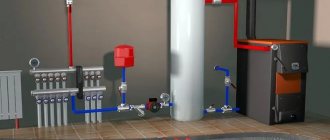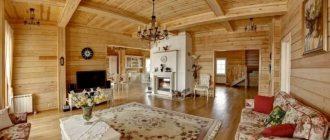Gas is considered the most cost-effective type of fuel in terms of efficiency. Even if there is no gas main line to the holiday village, many owners of country houses use gas tanks, which, from an economic point of view, is often more profitable than using other types of fuel. In any case, you need to know the rules for connecting a gas boiler in a private house, which strictly regulate all the nuances of installation and operation of the equipment.
A modern gas boiler with automation is a rather complex system, the installation and debugging of which requires specialized knowledge Source sovkalmykia.ru
Is it possible to install the equipment yourself?
In short, the installation of a gas boiler in a private house can be carried out by anyone, but commissioning of the equipment - acceptance and testing must be carried out by specialists from the gas service; connecting a gas boiler in a private house and operating it without their permission is impossible.
It is safest to entrust the installation of gas equipment to qualified representatives of a specialized organization. Only they will be able to carry out the necessary work competently, in accordance with the requirements of SNiP, and ensure the safe operation of the equipment. In addition, a competent specialist always works under a contract, which specifies who carried out what work, when and what.
Gas release
The second part of the start-up is the release of air from the pump, for which the heating regulators are brought to the operating position. The circulation pump turns on, which is accompanied by a faint hum and gurgle of water. To eliminate noise, you need to bleed air from the heating system: the cap in the center of the pump is slightly unscrewed, and when water begins to come out instead of gases, the cap is screwed back.
https://youtube.com/watch?v=taQJKUjiso8
After this, the noise will stop, the electric burner will start working, and the boiler will start working. You should also check the pressure and add more water if necessary. To set up a working system, you need to screw the batteries closest to the boiler, and start the distant ones using control valves, which are located in the water supply section to the radiators.
You also need to take care of the sewage system: during installation, you need to calculate the volume of condensate at the rate of 1 liter per 1 kW of equipment power per day.
Ventilation is located 25 cm from the ceiling with a diameter of 10 cm. Date: September 25, 2022
Main types of gas boilers
Manufacturers of gas equipment offer customers different types of heating boilers running on blue fuel. They are designed for heating any area and, according to the type of installation, are divided into floor and wall.
The first of them are powerful, reliable and durable “flagship models”, designed for installation in houses with above-average square footage. There is only one general drawback of such models - they will have to be equipped with a separate room.
Modern floor-standing gas boilers Source vsemixfight.ru
Wall-mounted gas boilers are an excellent alternative for a small private home: they do not require a separate room - such devices are compact and versatile. In addition, their installation does not impose increased conditions on the load-bearing capacity of the wall - it only requires a layer of non-combustible material between the boiler and the base.
Requirements for the boiler room in the house
If the boiler output is more than 30 kW, then it must be installed in a separate room. All information on how to install a gas boiler in a private house is given in the SNiP standards, where there are clear requirements for the arrangement of a boiler room for heating equipment powered by fuel combustion.
You can place the boiler room in the attic, in the basement (basement) or simply in a separate room of the house. A mandatory requirement for this is free passage into the room, sufficient illumination and the arrangement of a rigid base.
In addition, installing a gas boiler in a private house requires the following boiler room:
- volume of at least 13.5 m³ for boilers with a power of 30-60 kW and over 15 m³ for models with higher productivity;
- convenient access to equipment.
Properly designed boiler room for a private home Source teploknam.ru
- within an hour, ventilation should provide three air exchanges;
- walls and ceilings are made of non-combustible material;
Important! Heating boilers are located at a distance of at least 0.5 m from flammable surfaces. And the partitions comply with the fire resistance standard RE1 45, that is, they must resist open fire for 45 minutes.
Types of wall devices
According to their functional purpose, gas heating units are divided into two groups:
- Single-circuit. Intended for heating only. They are connected to the heating circuit and heat the coolant. The organization of hot water supply in this case is carried out by installing an electric or gas water heater of any type.
- Dual-circuit. They heat the room and provide hot water. An additional circuit for heating water is built into the boiler. The technological feature of the device is that it is impossible to simultaneously heat water and heat the room.
The priority action of dual-circuit units is to heat the water; heating operation stops at this time. Considering that water can be heated quickly, the boiler heats the building quite effectively.
If the tasks of the gas unit are planned to include both heating the coolant and supplying hot water, then it is better to purchase a double-circuit boiler. They come with one or two heat exchangers. When equipped with two, two circuits can be served simultaneously
According to the method of fuel combustion, all devices are divided into the following two groups.
Group #1 - devices with an open combustion chamber
Such devices are also called natural draft heating devices. They take the oxygen necessary for combustion from the room in which the device is located.
To remove combustion products, they need a traditional type chimney. Thus, a mandatory requirement for installing such a boiler is the provision of good ventilation.
If the heating device is installed in a residential area, it must be equipped with high-performance supply ventilation.
The best option for installing a heating device with an open firebox is the presence of a separate room, the so-called firebox, where it is placed.
Systems with natural ventilation are quite popular due to their low cost and energy independence.
The figure schematically shows boilers with open and closed type burners
Group #2 - devices with a closed combustion chamber
Turbocharged devices are equipped with a closed combustion chamber. They take the air, without which the combustion process is impossible, from the street. For this purpose, the devices are equipped with coaxial type chimneys.
Such a chimney is made in the form of a structure of two pipes, one of which is nested inside the other. The combustion products are discharged outside through the inner pipe.
At the same time, street air flows in the opposite direction through the gap between the two pipes. It is clear that boilers with a closed firebox do not in any way affect the composition of the indoor air, which makes it possible to install them even in living rooms.
In this case, it is necessary to equip a coaxial chimney system, which is higher cost and more complex installation compared to a separate traditional chimney.
Requirements for a boiler room in a separate building
The advantages of a separate boiler room are increased safety, reduced noise levels and the ability to use the freed up space for other purposes. The disadvantage will be that the heating system will become more expensive, since it will be necessary to install an additional thermally insulated pipeline branch.
At the same time, the requirements for such boiler houses are as follows:
- separate foundation ;
- concrete base for the boiler;
- forced ventilation , which should provide three air exchanges within an hour;
- fulfillment of requirements regarding the size of the boiler room;
- no more than two heating devices can be installed in one room
- doors to the street should open outwards;
SNiP requirements for the external boiler room of a private house Source karelia-dom.ru
See also: Catalog of companies that specialize in insulating country houses.
- wall surfaces and ceilings are made of non-combustible material;
- the presence of a window with a transom for daylight and emergency ventilation - the area of the window opening must be suitable for the volume of the room (0.03 m2 per 1 m³);
- presence of a chimney , if it is needed for the device being installed (for wall-mounted devices with a capacity of less than 30 kW, a coaxial pipe is allowed to exit through the wall).
A sewer pipe is also connected to the boiler so that water can be drained from the system when it is replaced.
Connecting an indirect heating boiler
If the heating system is built on the basis of a single-circuit boiler, it is necessary to determine the source of hot water. The simplest solution is to install a regular electric boiler in your home. But it will consume expensive electricity, which is not very profitable. It is much cheaper to connect an indirect heating boiler to the heating circuit.
The easiest way to connect a boiler to a boiler is to install small collectors and connect to them a pipe with a circulation pump and a check valve, which will go to the water heater, as well as a return pipe. By controlling the operation of the circulation pump, the boiler will turn the coolant supply on and off, regulating the temperature in the built-in tank. It is also possible to implement this circuit without a collector.
If, in addition to the boiler, additional circuits and heated floors are connected to your heating system, then you cannot do without collectors or a water gun.
Basic requirements for smoke exhaust and ventilation ducts
The room where the gas boiler is located must meet the necessary requirements, and not only the width and length of the room is regulated according to the power of the equipment, but also the size to the ceiling, which must be at least 2 m.
A ventilation duct must be installed in the boiler room; for this purpose, a hole with a cross-section of at least 0.02 m2 is provided.
The location of gas boilers corresponds to the installation conditions of the chimney. In this case, the parameters of the latter (height, channel area) in relation to the installed gas equipment must be strictly observed.
Chimneys for a gas boiler in a private house Source pinterest.ru
The size of the internal cross-section of the smoke outlet pipe is made the same or slightly larger than that of the device. According to NPB-98, inside the chimney opening the air flow speed should be 15-20 m/sec, and such draft can be ensured with a chimney pipe height of about 5 meters.
Important! Smoke must not be vented into a duct provided for ventilation. In boiler rooms that have a standard hood, air exchange should take place due to the incoming flow from outside the room and, partially, as a result of its penetration from adjacent rooms.
The best known manufacturers and models: characteristics and prices
Consumers whose budget for heating and hot water supply is not so limited should look for a super comfortable solution for China in products from German manufacturers. The middle price segment with a different set of options is occupied by products from other European or Asian countries. The Russian part of the market is also saturated with various options for outdoor gas boilers with almost any configuration at a significantly lower price.
Before deciding on a specific model of the future boiler, you need to decide: you only need a heating unit or a hot water unit, at what distance the boiler will be located and evaluate your own budget, then start looking at the following parameters:
- one or two circuits;
- power and efficiency;
- open or closed firebox;
- electric or piezoelectric ignition;
- appearance and design;
- cost of the product and reliability of the manufacturer.
After assessing these parameters for different models, you can decide on the purchase of equipment. Below we have given examples of the most successful and widespread models in Russia
BULAT series W and R
This is a joint development of the Russian Federation and Holland. Outdoor boilers of the W series are available with power from 24 kW to 105 kW, series R from 100 kW to 150 kW. The efficiency reaches 97%, which is considered a very high indicator for a convection gas boiler. Cascade power expansion, can include up to 3 heat exchangers, 3 pumps, 3 expansion tanks and 3 safety systems. Flexible automatic weather control and joint control of a cascade of boilers. Many additional options enhance user comfort; there is a GSM notification. The only drawback is the price.
Cost: 300,000-640,000 rubles.
Phoenix Series
A Russian-made set (Teplocenter LLC) of one or two boilers with an open firebox with atmospheric burners and circulation pumps, equipped with gas analyzers and emergency alarms (GSM). Single units are produced with heating capacity from 40 to 500 kW, double units - from 80 to 800 kW, with an efficiency of 92%. Individual equipment with cascade and weather power control systems is possible. In general, the series is distinguished by its individualization capabilities: choice of the boiler model used, automation options, notification not only via GSM, but also Ethernet. In terms of dimensions, the design is not compact.
Cost: 211,000-771,000 rub.
RS-H Series
RS-H units with an open firebox are equipped with an atmospheric burner and a circulation pump. Single boilers up to 100 kW have piezoelectric ignition and Italian safety automatics, the rest are equipped with electric ignition and American automatics. Flexible possibility of completing with additional options at the customer's request. The boilers of this series belong to the class of hydronic boilers (with a coolant velocity in the pipes of 1.5-2 m/sec), which makes it possible to maintain an extremely stable temperature even with strong heat losses.
Cost: from 240,000 rub. to calculated individually.
Gas appliance in a private home: requirements and main installation steps
To properly install the unit, you must first study the regulatory documentation and rules for performing this work. They talk about the features of installing gas appliances for the heating system.
Whatever type of boiler would have to be installed, it is imperative to comply with the requirements of certain norms and rules, such as:
- SNiP 41-01-2003 on heating, ventilation and air conditioning.
- SNiP 42-01-2002 on the gas distribution system.
- SNiP 21-01-97 on fire safety.
- SNiP 2.04.08-87 on the installation of boiler houses.
SNiP provisions contain all the necessary information for installing and starting a gas boiler Source optolov.ru
Operating rules
For safe use of gas, the connection diagram for a gas boiler in a private house must be followed. In addition, the following conditions :
- For starting the boiler only at normal humidity.
- Monitoring of technical condition by gas service specialists at least once a year.
- Installing a fine filter on the return pipe of the heating system.
- Natural or artificial ventilation in the boiler room.
- Compliance of draft in the chimney pipe with the requirements (10-20 m/sec).
In the event of a leak, promptly report to the emergency gas service.
What it is?
An autonomous heating system involves a complete rejection of central heating.
That is, it will be necessary to dismantle the radiators and pipes related to this system. The basis of individual heating in this case will be gas or electric boilers. And to them, in turn, new pipes and batteries should be attached. The principle of operation of boilers is quite simple - they heat water and send it to circulate through the created system, thereby heating the premises in the required mode.
Maintenance
Preventive measures for routine inspection of gas boilers include the following types of work :
- Checking the valves of the external and internal gas pipelines (disassembling, applying lubricant).
- Inspection of thermostats on floor-standing boilers.
- Washing or replacing filter elements.
- Inspection of nozzles , checking the tightness of the door, the operation of the igniter on floor-standing devices.
- draft control
- ice build-up in winter .
All components that have been subject to wear during operation must be replaced.
On a note! After completion of the repair and before starting the heating system, the gas service worker checks the tightness of all connections in the line. Usually a soap solution is used for this.
A competent preventive inspection will not only increase the service life of the equipment in use, but will also reduce gas consumption.
Repair and maintenance of gas equipment Source sanmaster62.ru
Floor type
Installing a floor-standing boiler is also not difficult, you need:
- Prepare a strong pedestal that can support the weight of the boiler. This is usually done by pouring a concrete solution, sometimes a sheet of galvanized iron is securely laid on the floor.
- Install the boiler, leveling its position using a building level.
- Connect the chimney to the unit, check the draft if there is no forced exhaust.
- Connect the device to the heating system by installing a filter at the end of the outlet line, i.e. just before the entrance.











